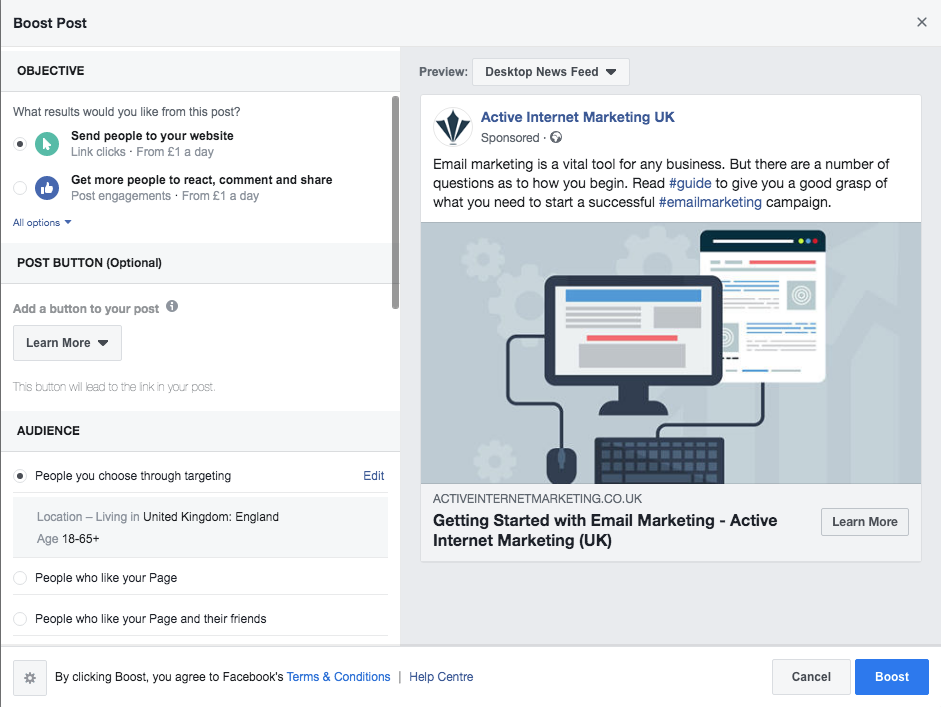Let’s start with a simple, but fairly loaded and perhaps controversial question: is boosting a Facebook post on your business page worth it? The short answer is no, boosted posts are not worth it (we told you it was a controversial answer!), especially if you’re looking to increase sales and gain tangible advertising results. Boosting a Facebook post is only really worth your time and money if you’re looking to build and increase social engagement alone.
What are boosted posts on Facebook?
A boosted post is a form of advertising on Facebook that allows you to increase the reach on a specific post. If your post is eligible for boosting you can click the button, and you will see a range of options:
- Setting your objective – e.g. link clicks or post engagements
- Adding a button
- Selecting an audience – targeting specific age ranges, people who like your page plus their friends, or people within the local area
- And, setting the duration and budget – this generates an estimated reach of people per day

What is the purpose of a Facebook boost post?
As you may have already gathered from the only two objectives you can set, the primary purpose of a boosted post is to gain engagement or encourage visitors to your website.
There are many benefits to increasing engagement. Engagement is defined as gaining likes, comments and shares from users. These types of interactions are great if you want to increase and spread brand awareness, increase your social following and individual post stats, as well as potentially attract new customers or visitors to your website. Engagement is one of the key metrics many social media platforms use to determine whether your content shows up in your followers’ feeds, and beyond.
Why use boosted posts?
- Effective way to test your creativity before spending money on a larger scale ad campaign. You can instantly see what types of reactions you can get with your ad. However, you can also do this in Ad Manager
- Increase visibility within the organic news feed, and communicate something to your followers
- Use them to optimise ads. You can help your ad convert better when it has social proof, all you have to do is copy and paste the unique post number into Ad Manager when clicking ‘use existing post’ and then enter the ID under creative
For many businesses, boosting a post on Facebook is a quick, simple and relatively low effort form of advertising. With many of us having incredibly busy schedules and workloads, it’s handy to have one button to click and then a whole host of individuals view and engage with our post almost instantaneously.
The ease with which Facebook allows you to boost posts makes it very tempting for us, particularly for those who are specifically looking to gain more likes, comments or shares on their social posts. Increasing reach and driving users to your website is great – especially when the metrics are high – but it doesn’t guarantee quality leads or conversions.
While a boosted post is accessible, tempting and seemingly irresistible – especially with the estimated reach being ‘up to 13,000 people’, it’s easy to see why this is such a popular advertising tool. But, it is, however, not the most effective form of Facebook advertising available to businesses.
This is because boosted posts essentially crawl the social platform for high engagement and active users. Active users could be absolutely anyone, and they don’t even have to be interested in your products or services. The targeting preferences are not driven by what you’re offering and who is likely to buy, they are dictated by who is most active and a frequent user on the site.
A boosted post only focuses on engagement and targets the small percentage of people that are most likely to interact with your ad.
Facebook boost posts do what they say on the tin: allowing more people ‘to see and engage with your post’. But, what it doesn’t explicitly tell you is that it doesn’t offer you leads, conversions, sales or any actual brand awareness. As a business, these are the types of objectives and goals you want to increase.
We don’t want to burst your bubble and ruin all your hopes and dreams for social media advertising. Instead, we want to highlight another (better) option for you and your business to consider.
What tool should you use instead?
Unless your only goal is to drive social engagement, boosting a Facebook post is simply not worth your monetary investment or time. Leave it alone, stop clicking the button as regularly, and instead use Ad Manager – you can thank us later.
Why is Ad Manager different to boosted posts? Firstly, it allows you to set more focused campaign objectives and goals such as conversions, sales, brand awareness, and the list goes on. These are far more beneficial and targeted metrics for a business.
As Ad Manager has a wider scope of ad targeting options, you can align it with your business objectives, which means that you can build more effective campaigns and focus your ads around your specific goal or target. In turn, this will see a far better return on investment as you will gain quality leads, boosting conversions and gaining traffic that is far more likely to have a purchase intent.
Conclusion: ‘To boost or not to boost?’, that is the question
Just because boosting a post is easy to use and implement, it doesn’t mean that it matches every business’ advertising goal. As we have said previously, boosted Facebook posts are great if you are trying to drive engagement; but, if you’re trying to drive sales or traffic to your website, then they are not effective.
Contact Active Internet Marketing
If you’re interested in social media marketing, or any of our other digital marketing services here at Active Internet Marketing, please get in contact with our expert and friendly team today by calling 01604 765 796, or through filling out our online contact form, and we’ll be in touch.
Template for the white papers to allow downloading of locked content







